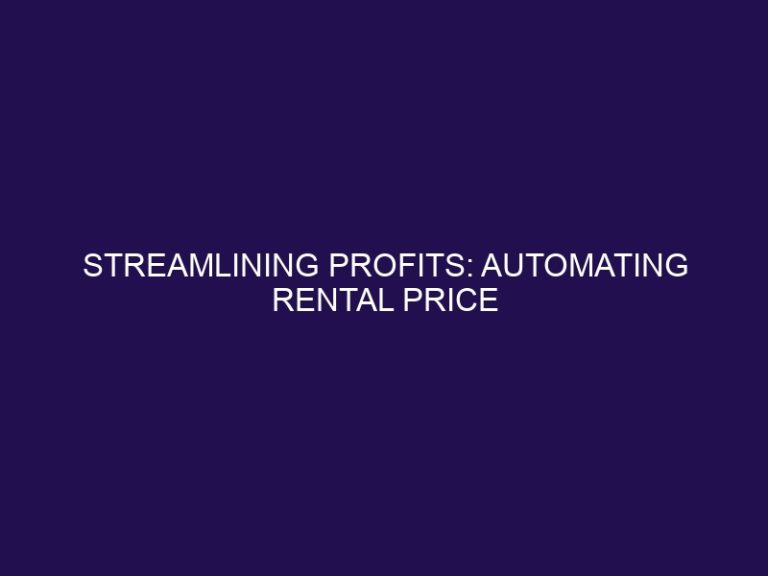Rental Price Elasticity: Finding the Sweet Spot
Rental price elasticity refers to the measure of the responsiveness of the rental market to changes in the rental price. This concept is important for landlords and property owners as it helps them to determine the optimal rental price for their properties. Understanding rental price elasticity can help landlords find the “sweet spot” – where the rental price is neither too high nor too low, resulting in the maximum benefits for both the landlord and tenants.
The key to understanding rental price elasticity lies in understanding how it works. It takes into account the factors that affect the rental market, such as the location, demand for housing, supply of housing, and economic conditions. These factors can influence how tenants respond to changes in rental prices, and ultimately impact the success of a rental property.
For example, a highly desirable location with a high demand for housing will have higher rental price elasticity, meaning that tenants are more likely to accept higher rental prices. In contrast, an oversupply of housing in a particular area can lead to lower elasticity, with tenants being more sensitive to rental price changes.
So, what is the ideal rental price elasticity? The answer lies in finding the “sweet spot.” A rental price elasticity that is too high or too low can have negative implications for the landlord and the tenants.
If the elasticity is too high, tenants may be less likely to stay long-term, leading to higher turnover rates and potential vacancies. On the other hand, if the elasticity is too low, rental properties may not be able to attract enough tenants, resulting in lower occupancy rates and potential losses for landlords.
To find the sweet spot for rental price elasticity, landlords should consider various factors such as the local market conditions, unique features of the property, and economic trends. By conducting thorough research and analysis, landlords can determine the optimal rental price that will maximize profits, attract and retain tenants, and avoid vacancies.
Ultimately, finding the sweet spot for rental price elasticity can bring numerous benefits for landlords, including maximizing profits, attracting and retaining tenants, and avoiding vacancies. Thus, it is crucial for landlords to understand and utilize rental price elasticity to their advantage in the competitive rental market.
What Is Rental Price Elasticity?
What Is Rental Price Elasticity? Rental price elasticity is the measure of how responsive rental demand is to changes in rental prices. It allows landlords and property managers to determine the optimal rental prices that will result in the highest revenue and occupancy rates.
How Does Rental Price Elasticity Work?
- Understand Demand: Analyze market demand for rentals in the specific area.
- Price Adjustment: Increase or decrease rents based on demand fluctuations.
- Observation: Monitor tenant response to price changes to gauge elasticity.
To optimize, evaluate local economy and demographic trends and understand how rental price elasticity works.
What Factors Affect Rental Price Elasticity?
When it comes to determining rental prices, there are several factors that come into play. These factors ultimately affect the rental price elasticity of a property, or how sensitive the demand for housing is to changes in rent. In this section, we will discuss the main factors that influence rental price elasticity, including location, demand for housing, supply of housing, and economic conditions. Understanding these factors is crucial in finding the “sweet spot” for rental prices that will satisfy both landlords and tenants.
1. Location
- Conduct thorough research on the neighborhood’s location, safety, amenities, and proximity to public transport.
- Evaluate the neighborhood’s potential for growth and any future development projects.
- Analyze the demographic trends and cultural appeal of the neighborhood.
2. Demand for Housing
Demand for housing is a crucial factor in determining rental price elasticity. Various factors, such as population growth, job opportunities, and migration patterns, play a significant role in influencing the demand for housing. In areas with high demand, landlords have the advantage of setting higher rents due to limited availability. Having a thorough understanding of these demand dynamics can help landlords effectively optimize their rental pricing strategies.
3. Supply of Housing
- Assess local housing inventory.
- Evaluate new construction plans and housing developments.
- Analyze historical data on the supply of housing.
Pro-tip: Collaborate with local real estate agents for up-to-date insights on housing supply trends.
4. Economic Conditions
Economic conditions play a significant role in the elasticity of rental prices. In times of economic downturn, there may be a higher demand for rental properties as people choose to rent rather than buy. On the other hand, during economic upswings, increased purchasing power may lead to a decrease in rental demand, which can impact elasticity.
In the event of a recession, landlords may adjust rental rates in order to increase occupancy and reduce vacancies.
What Is the Ideal Rental Price Elasticity?
When it comes to setting rental prices, finding the right balance between elasticity is crucial. In this section, we will discuss the concept of rental price elasticity and its impact on the rental market. We will examine the potential consequences of setting the rental price too high or too low, and how it can affect both landlords and tenants. By understanding the ideal level of rental price elasticity, we can make informed decisions about setting prices that benefit both parties.
1. Too High Elasticity
- Decrease Rent: If the elasticity is too high, landlords can consider lowering the rent to stimulate demand.
- Improve Property: Enhance property features and amenities to justify current rent levels.
- Monitor Competitors: Compare rental prices in the area and adjust accordingly.
2. Too Low Elasticity
- Conduct thorough market research to understand local rental trends.
- Identify unique property features to differentiate from competitors.
- Analyze the balance between rental demand and housing supply.
- Monitor economic indicators for potential shifts, including the possibility of too low elasticity in rental prices.
The Great Depression of the 1930s saw a significant decrease in rental price elasticity as housing demand plummeted, leading to a surplus of vacant properties across the United States.
How Can Landlords Find the Sweet Spot for Rental Price Elasticity?
As a landlord, finding the right rental price for your property can be a delicate balance. Too high and you risk deterring potential tenants, too low and you may not be maximizing your profits. This section will discuss how landlords can find the sweet spot for rental price elasticity by taking into account various factors. We’ll cover researching the local market, considering the property’s unique features, analyzing the demand and supply balance, and keeping an eye on economic trends. These steps will help landlords make informed decisions and find the optimal rental price for their property.
1. Research the Local Market
- Conduct research on rental prices in the local area.
- Analyze current rental trends and demand.
- Explore different property types and amenities available in the vicinity.
2. Consider the Property’s Unique Features
- Identify distinctive property characteristics such as location, architectural style, and amenities.
- Analyze how these features align with the target tenant demographic and local market demands, taking into consideration the unique aspects of the property.
- Showcase these unique features in property listings to attract suitable tenants.
A property owner highlighted a historic building’s unique architecture and period-specific features, drawing in tenants who appreciated its character and history.
3. Analyze the Demand and Supply Balance
- Assess the local demand for housing in the target area.
- Evaluate the current supply of available rental properties.
- Analyze the balance between demand and supply to gauge rental price elasticity.
4. Keep an Eye on Economic Trends
- Monitor economic indicators such as employment rates, GDP growth, and inflation.
- Stay updated with local economic trends, including industry growth and business expansions.
- Assess the impact of economic policies and interest rate changes on housing demand and affordability.
What Are the Benefits of Finding the Sweet Spot for Rental Price Elasticity?
In the world of property rental, setting the right price can make all the difference between success and failure. This section will delve into the benefits of finding the “sweet spot” for rental price elasticity, where the price is not too high to scare away potential tenants, but also not too low to miss out on potential profits. We will discuss how this optimal pricing strategy can maximize profit, attract and retain tenants, and help avoid costly vacancies. Let’s explore the advantages of finding the perfect balance for rental prices.
1. Maximizes Profit
- Invest in property upgrades to maximize rental value.
- Regularly review and adjust rental prices based on market trends to increase profit.
- Offer incentives to encourage longer lease agreements and increase profitability.
- Ensure efficient property management to minimize operational costs and maximize profit.
A real estate investor, by optimizing rental price elasticity, significantly increased their property’s profitability. By implementing dynamic pricing strategies and enhancing property features, they attracted long-term tenants, ensuring consistent revenue streams while maintaining high occupancy rates.
2. Attracts and Retains Tenants
- Create an appealing living space with modern amenities and a well-maintained property.
- Offer competitive rental rates to attract and retain tenants.
- Provide excellent customer service and respond promptly to tenants’ needs.
- Establish clear communication channels for addressing tenant concerns.
- Ensure a safe and secure environment for tenants.
By prioritizing tenant satisfaction and implementing strategies to attract and retain tenants, landlords can foster long-term tenant relationships, leading to higher occupancy rates and a positive reputation in the rental market.
3. Helps to Avoid Vacancies
- Offering competitive rental rates based on thorough market research to help avoid vacancies.
- Highlighting unique property features to attract potential tenants and avoid vacancies.
- Ensuring rental prices are in line with demand and supply dynamics to help avoid vacancies.
- Staying informed about economic trends to adjust rental rates and avoid vacancies.
By strategically setting rental prices, landlords can minimize vacancies and maximize profitability while meeting the needs of tenants.
Frequently Asked Questions
What is rental price elasticity and why is it important for businesses?
Rental price elasticity refers to the sensitivity of demand for rental properties to changes in their price. It is important for businesses as it helps them understand how their customers will respond to changes in rental prices, and allows them to make strategic decisions to maximize profits and maintain consumer satisfaction.
How is price elasticity of demand calculated?
The price elasticity of demand is calculated by taking the percentage change in quantity demanded and dividing it by the percentage change in price. This can be done using the midpoint method, which takes the average percent change in both quantity and price to ensure consistent results regardless of price increases or decreases.
How does price elasticity of demand influence business decisions?
Price elasticity of demand plays a crucial role in business decisions as it helps companies determine the optimal price for their products or services. Highly elastic products may see a significant decrease in demand with even a small price increase, while inelastic products will have a smaller change in demand in response to price changes.
What is price skimming and when is it a successful pricing strategy?
Price skimming is a pricing strategy where companies set a high price for a product initially and gradually decrease it over time. This strategy can be successful for new and innovative products, allowing businesses to establish their product as a premium brand and generate maximum revenue. However, it may not be sustainable in the long term as competitors enter the market.
How do production costs and market equilibrium affect rental price elasticity?
Production costs play a significant role in rental price elasticity, as they can impact the supply of rental properties. Market equilibrium, where the supply and demand for rental properties meet, can also influence rental price elasticity. If production costs increase, rental prices may also increase, and vice versa.
How do luxury cars and prescription medications demonstrate different levels of price elasticity of demand?
Luxury cars and prescription medications are examples of products with different levels of price elasticity of demand. Luxury cars are highly elastic, meaning that even a small price increase can lead to a significant decrease in demand. On the other hand, prescription medication is often inelastic, with consumers willing to pay high prices for necessary medication. This difference in elasticity can impact successful pricing strategies for these products.







![What Is The Empty Homes Tax? [Canada]](https://rentincrease.ca/wp-content/uploads/2023/10/what-is-the-empty-homes-tax-canada_2653-768x576.jpg)